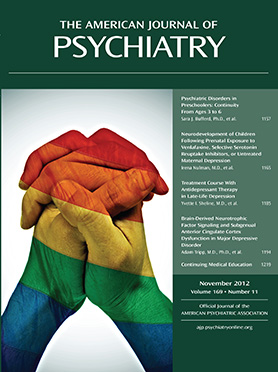T
o the E
ditor: We read with interest the article by Brunelin et al. (
1) in the July issue, which described the application of transcranial direct-current stimulation (tDCS) in the treatment of both auditory hallucinations and negative symptoms simultaneously. Fifteen patients received 10 tDCS treatments and another 15 patients received sham stimulation. An effect size of 1.58 was reported for refractory hallucinations, which is remarkably large when compared with the effect sizes of antipsychotic medication (0.4–0.6). The effect size for negative symptoms was also larger than 1.
Clinical trials involving nonconvulsive brain stimulation in schizophrenia were first introduced in 1999. Initial effect sizes were very large while samples were small. Some years later, large negative studies were published. To date, 17 placebo-controlled transcranial magnetic stimulation (TMS) studies on hallucinations have been published. The mean weighted effect size is now around 0.3 (
2). Yet, the negative correlation between effect size and year of publication suggests that over time, the mean effect size may become smaller.
The trend of effect sizes for new techniques decreasing over time is by no means specific for TMS or tDCS. It is a general trend that can be observed when new treatments are introduced (
3). For example, when selective serotonin reuptake inhibitors (SSRIs) were introduced for depression, effect sizes greater than 1 were reported, which created their legacy as a wonder drug. Over the course of 20 years, the mean effect size of SSRIs decreased to around 0.3. A similar trend was demonstrated for cognitive-behavioral therapy (
4).
This trend likely results from publication bias. A remarkably high effect size suggests the discovery of a new wonder treatment. Studies with such findings are therefore easily published in high-impact journals (
5). In contrast, studies of similar sample size with marginally or nonsignificant findings are less likely to be accepted for publication. Usually, after some years, negative studies with large sample sizes become available. This is when meta-analyses start to detect a decrease in efficacy.
In this view, the Brunelin et al. study (
1) is exemplary of an initial placebo-controlled study applying a new technique: it included a small sample, found remarkably large effects, and is published in a high-impact journal.
We sincerely hope that tDCS is the exception to the rule—as a cheap, safe, and highly effective method to treat both refractory hallucinations and negative symptoms is most welcome. However, given the previous observations for other new treatments, it is realistic to expect that 10 years from now the mean weighted effect size of tDCS will be around 0.3.

